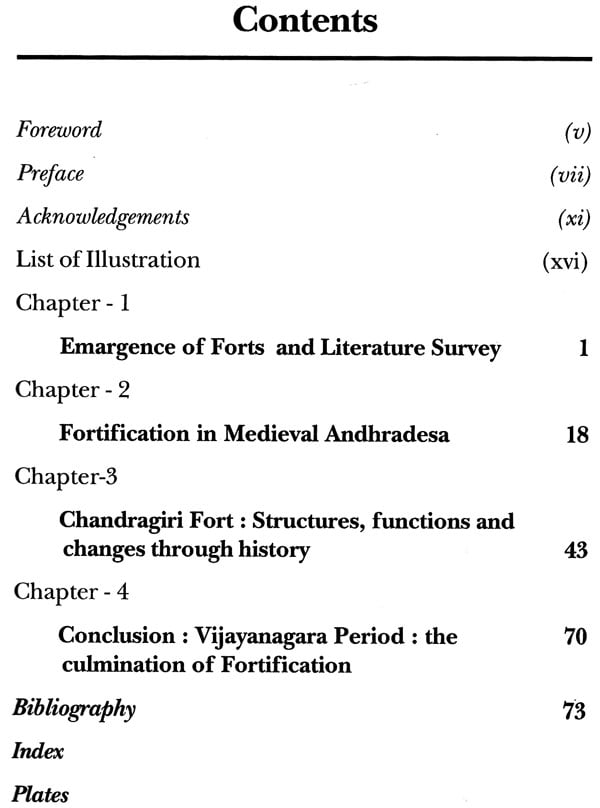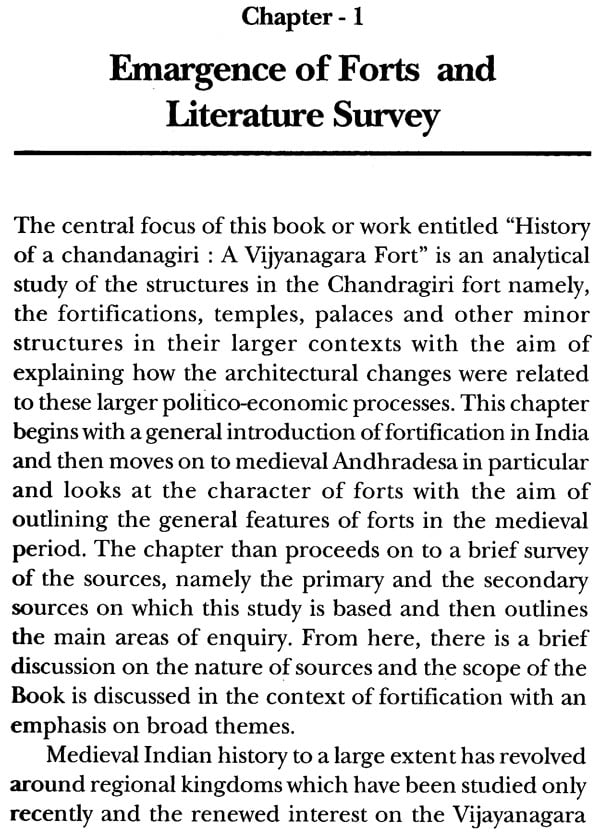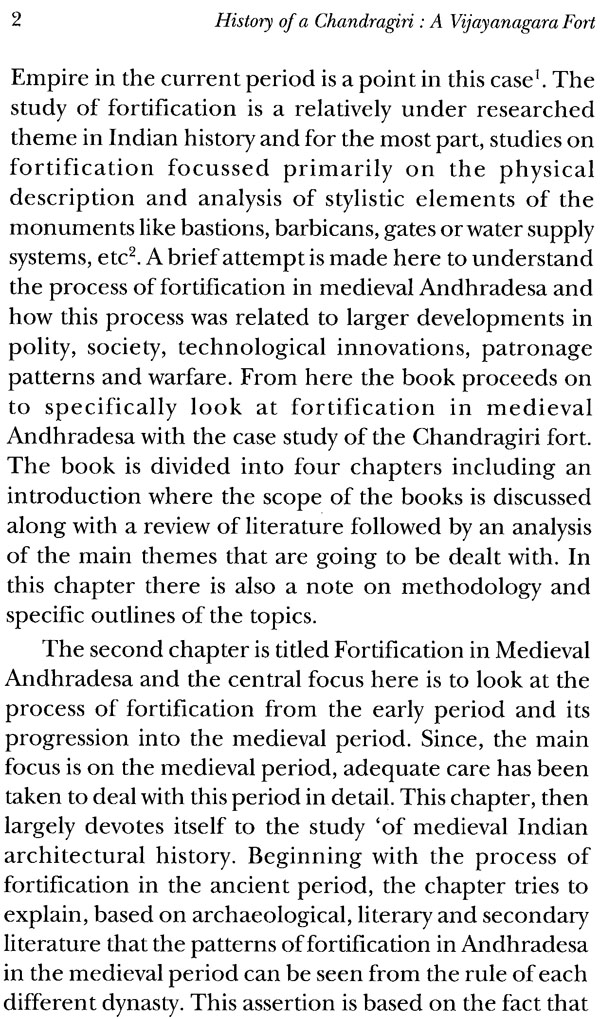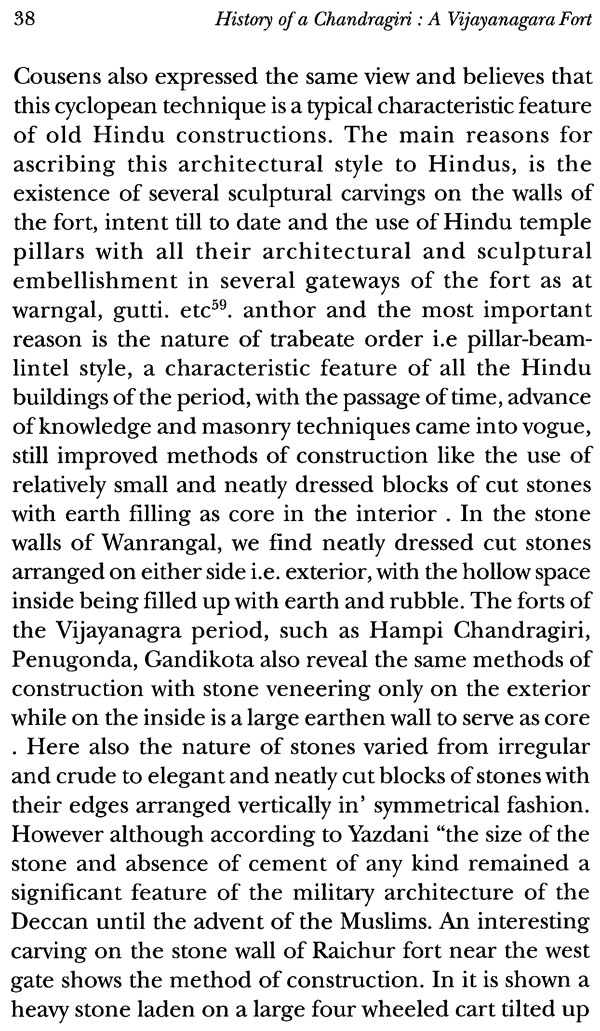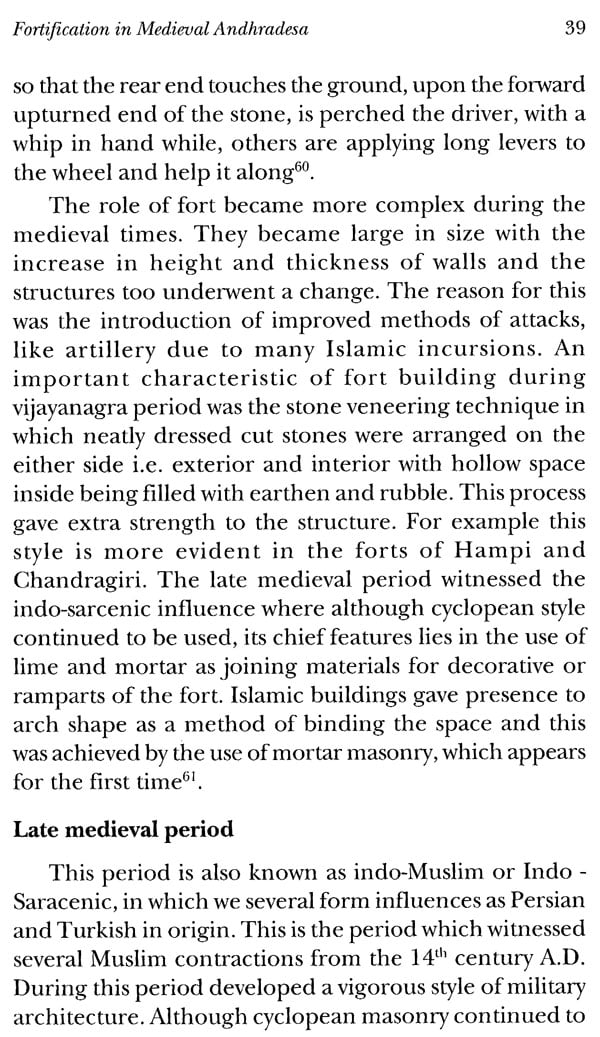
Chandragiri: A Vijayanagara Fort
Book Specification
| Item Code: | NAV601 |
| Author: | Meesala Rama Krishna |
| Publisher: | Pratibha Prakashan |
| Language: | English |
| Edition: | 2019 |
| ISBN: | 9788177024470 |
| Pages: | 104 (15 Color Illustrations) |
| Cover: | HARDCOVER |
| Other Details | 9.00 X 6.00 inch |
| Weight | 310 gm |
Book Description
The central focus of this book entitled "Chandragiri: a vijayanagara Fort" is an analytical study of the structures in the Chandragiri fort namely, the fortifications, temples, palaces and other minor structures in their larger contexts with the aim of explaining how the architectural changes were related to these larger politico-economic processes. Medieval Indian history to a large extent has revolved around regional kingdoms which have been studied only recently and the renewed interest on the Vijayanagara Empire in the current period is a point in this case.
A brief attempt is made here to understand the process of fortification in medieval Andhradesa and how this process was related to larger developments in polity, society, technological innovations, patronage patterns and warfare.
This book begins with a general introduction of fortification in India and then moves on to medieval Andhradesa in particular and looks at the character of forts with the aim of outlining the general features of forts in the medieval period, than proceeds on to a brief survey of the sources, namely the primary and the secondary sources on which this study is based and then outlines the main areas of enquiry. From here, there is a brief discussion on the nature of sources and the scope of the book is discussed in the context of fortification with an emphasis on broad themes. . From here the book proceeds on to specifically look at fortification in medieval Andhradesa with the case study of the Chandragiri fort.
Dr. Meesala Ramakrishna obtained his doctoral degree in History in 2014 from the Department of History, University of Hyderabad, India. He Published papers in national and international journals and also contributed to chapters for edited books. He presented several research papers in national and international conferences and participated .Presently working as Guest Faculty in Department of History, Pondicherry University, and also worked as Lecturer in History in BSSB Degree College , Tadikonda, Guntur, A.P and Research Assistant, in UPEII, University of Hyderabad .Participated in Megalithic Burial Exaction at Khamam SR &BGNR Degree College, Documentation Assistant under the National Mission on Monuments and Antiquities (NMMA).Participated in Field Work at Nagarjunakonda and Amaravathi, in Guntur District, A.P..Participated in Field Work at MUDUMAL (Megalithic Site) Mahaboob Nagar District, A.P. Participated in Excavation at KONDAPUR, Medak District, A.P (Satavahana Site) Under the ASI Bhuvaneshvar Circle, and Convener for History Forum, Department of History, University of Hyderabad .Participated in Field work on Forts, in Nizamabad District, With Dr. Carl Smith & Dr. M.N.Rajesh under UPE Project. Participated in Excavation at University of Hyderabad (Megalithic Site).
Fortification was an important process of construction of the kingdom's identity all over the world, especially during the medieval period: be it Europe or the Asian kingdoms and empires. Fortifications were not only the tangible symbols of strength but also were the statements of architectural aesthetics with fine and nuanced blending different cultures, lifestyles and thought processes. These structures like castles in Europe and forts in Asia, especially in the Indian sub-continents are the live testaments, which are also crucial source of medieval historiography inspiring researchers and scholars to study the phenomena of fortifications and its impact on polity, culture and society. Study of fortification in India has largely been an under-researched area that requires in-depth enquiry and research so as to understand complex relationship of structures of central power with local principalities and fiefdoms in particular and society at large.
Dr. Ramakrishna's work is a unique contribution in this regard, where he endeavours to explore the process of fortification not from the architectural perspective rather from the process-oriented perspective. His focus is just not on physical description and analysis of stylistic elements of the monuments like bastions, barbicans, gates or water supply systems etc. bit but he attempts to understand the process of fortification in medieval Andhradesa and how this process was related to larger developments in polity, society, technological innovations, patronage patterns and warfare. This focus is a major departure in this study and makes it unique. To understand these processes, Dr. Ramakrishna has chosen the Chandragiri Fort in the medieval Andhradesa.
In the course of his study, he has provided rich reviews of literature on the subject from the archaeological to intellectual sources covering vast range of variety on the art, aesthetics, styles and spatio-temporal dynamics. Chapter Two and Three are exclusively devoted to the study of medieval Indian architectural history. Beginning with the process of fortification in the ancient period, the chapter tries to explain, based on archaeological, literary and secondary literature that the patterns of fortification in Andhradesa in the medieval period can be seen from the rule of each different dynasty. This assertion is based on the fact that the fort was a living monument and hence each dynasty has left its own imprints in the form of new architectural devices, stylistic patterns or more importantly advances in military technology that are visible even to the informal observer in the form of bastions, parapets and barbicans. With close scrutiny of these facts and sources, the author explores relationship between fortification and empire building in medieval Andhradesa.
The central focus of this book entitled "Chandragiri: a vijayanagara Fort" is an analytical study of the structures in the Chandragiri fort namely, the fortifications, temples, palaces and other minor structures in their larger contexts with the aim of explaining how the architectural changes were related to these larger politico-economic processes. Medieval Indian history to a large extent has revolved around regional kingdoms which have been studied only recently and the renewed interest on the Vijayanagara Empire in the current period is a point in this case. The study of fortification is a relatively under researched theme in Indian history and for the most part, studies on fortification focussed primarily on the physical description and analysis of stylistic elements of the monuments like bastions, barbicans, gates or water supply systems, etc. A brief attempt is made here to understand the process of fortification in medieval Andhradesa and how this process was related to larger developments in polity, society, technological innovations, patronage patterns and warfare.
This book begins with a general introduction of fortification in India and then moves on to medieval Andhradesa in particular and looks at the character of forts with the aim of outlining the general featutes of forts in the medieval period, than proceeds on to a brief survey of the sources, namely the primary and the secondary sources on which this study is based and then outlines the main areas of enquiry. From here, there is a brief discussion on the nature of sources and the scope of the book is discussed in the context of fortification with an emphasis on broad themes. . From here the book proceeds on to specifically look at fortification in medieval Andhradesa with the case study of the Chandragiri fort. The book is divided into four chapters including an introduction where the scope of the dissertation is discussed along with a review of literature followed by an analysis of the main themes that are going to be dealt with. . The second chapter is titled Fortification in Medieval Andhradesa and the central focus here is to look at the process of fortification from the early period and its progression into the medieval period. Since, the main focus is on the medieval period, adequate care has been taken to deal with this period in detail. This chapter, then largely devotes itself to the study 'of medieval Indian architectural history. Beginning with the process of fortification in the ancient period, the chapter tries to explain, based on archaeological, literary and secondary literature that the patterns of fortification in Andhradesa in the medieval period can be seen from the rule of each different dynasty. This assertion is based on the fact that the fort was a living monument and hence each dynasty has left its own imprints in the form of new architectural devices, stylistic patterns or more importantly advances in military technology that are visible even to the informal observer in the form of bastions, parapets and barbicans.
**Contents and Sample Pages**
